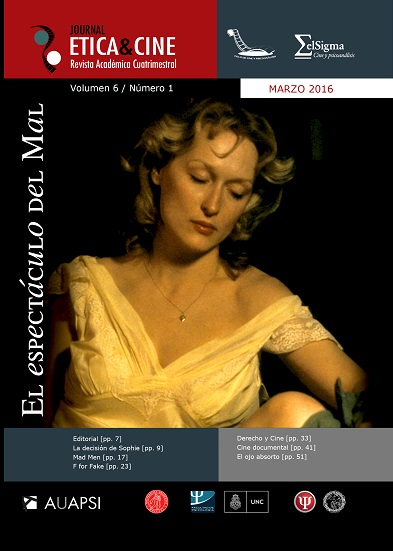Book reviews: Three semblances of the human body
DOI:
https://doi.org/10.31056/2250.5415.v6.n1.14861Keywords:
The eye absorbed, Alberto Garrandés, 2014Abstract
Absorbed - from the Latin ab-sorptus - is the past participle of the verb absorb, literally, "ingest", "absorb", "swallow". From the outset then, the-eye-absorbed is a disturbing phrase. An eye that swallows what it sees. An eye, an organ, which becomes a body. But not to be satisfied with what it devours, but to make it poetry. To transform it, from the look returned to us by the cinema screen. The cover of the book already puts us on topic. It is a work of the unique Cuban designer Pepe Menéndez, and represents an eye, with its bluish iris and a black pupil, framed in a film reel. The resulting object is supported on a white surface, as if this peculiar "eye-cook" could be separated from the body. Or better: as if the eye itself, cinema through, had become a body itself - autonomous, fragmented, but body at last. At the beginning of our journey, then, the body already appears intervened. As if the author warned us, from the image of the cover, that within the limits of the cinematographic frame, the body is sighted, examined and metamorphosed by virtue of the exercise of seeing. This review of the work of Alberto Garrandés1 proposes, in fidelity with the author, an interlocution with the real nucleus that his essays distil. The proposal is relatively simple: three young Argentine researchers contribute their texts in tune with two passages from The Absorbed Eye. They do not comment on the book, but multiply it, contributing the analytical reading of Rio de la Plata. Garrandés' book, enormous in itself, is supplemented by this narrative and at the same time ethical-clinical exercise. Because now the body emerges doubly treated: from the literary essay and from the cinema as an outline, as a rudiment of an analysis. To the various sources referred to by Garrandés, authors such as Alain Badiou, Jacques Lacan, Julio Cabrera, Barbara Cassin, Massimo Recalcati, Stanley Cavell, Slavoj Zizek are added, thus giving the body a statute that transcends its initial edges. Statute that emerges from an unthinkable meeting between Havana and Buenos Aires.
Downloads
References
Badiou, A. y Cassin, B. (2011), No hay relación sexual. Dos lecciones sobre L ? Étourdit de Lacan. Buenos Aires: Amorrortu Editores.
Cabrera, J. (2006), Cine: 100 años de filosofía. Barcelona: Gedisa.
Cavell, J. (1971), The world viewed: Reflections on the ontology of films. New York: The Viking Press.
Domínguez, M. E. (2008), “Los derechos humanos: una excepción que haga lugar al no-todo”. Anuario de Investigaciones, Facultad de Psicología, UBA, vol. XV, 2008, pp. 227-235.
Lacan, J. (1988), El Seminario. Libro 7. La ética del psicoanálisis (1959-1960). Buenos Aires: Ediciones Paidós.
Miller, J.A. (2002), Biología lacaniana y acontecimiento del cuerpo. Buenos Aires: Colección Diva.
Recalcati, M. (2007), La última cena. Buenos Aires: Ediciones del Cifrado.
Zizek, S. (2015), Mis chistes, mi filosofía. Buenos Aires: Anagrama.
Downloads
Published
How to Cite
Issue
Section
License
Los autores que publiquen en Ética y Cine Journal aceptan las siguientes condiciones:
Los autores/as conservan los derechos de autor © y permiten la publicación a Ética y Cine Journal, bajo licencia CC BY-SA / Reconocimiento - Reconocimiento-CompartirIgual 4.0 Internacional. La adopción de esta licencia permite copiar, redistribuir, comunicar públicamente la obra, reconociendo los créditos de la misma, y construir sobre el material publicado, debiendo otorgar el crédito apropiado a través de un enlace a la licencia e indicando si se realizaron cambios.

Este obra está bajo una licencia de Creative Commons Reconocimiento-CompartirIgual 4.0 Internacional.




